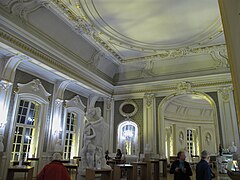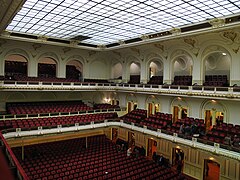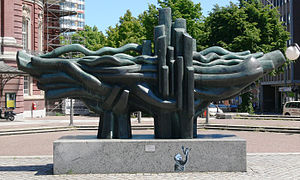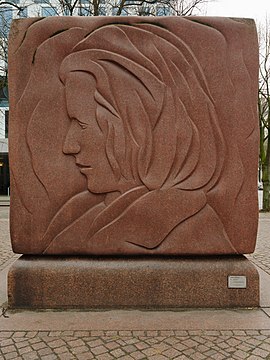Laeiszhalle

The Laeiszhalle (pronounced "Laißhalle"), formerly the Hamburg music hall , is a traditional concert hall on Johannes-Brahms-Platz in Hamburg . It was built in neo-baroque style and inaugurated in 1908. Its large hall offers 2025 seats and an organ built in 1951. The small hall has 640 seats.
Christoph Lieben-Seutter has been General Director of the Laeiszhalle since 2007 . He is also responsible for the Elbphilharmonie , which opened on January 11, 2017 . The Symphoniker Hamburg are the orchestra of the Laeiszhalle.
history
The Laeiszhalle is an example of the bourgeois Hanseatic patronage of the old city republic . The Hamburg shipowner Carl Laeisz bequeathed 1.2 million marks to the city in his will for the construction of “a worthy place for the practice and enjoyment of noble and serious music”. His widow Sophie Laeisz later increased the amount to 2 million marks. The music hall was built from 1904 to 1908 under the direction of the architects Martin Haller and Emil Meerwein on a plot of land provided by the city on Wallring in the neo-baroque style of the time (see also historicism ). The inauguration took place on June 4, 1908. When it opened, it was the largest and most modern concert hall in Germany.
The square in front of the music hall was initially called Holstenplatz, was renamed Karl-Muck- Platz in 1934 and has been called Johannes-Brahms- Platz since 1997 .
The centrally controlled ventilation and heating system came from the Hamburg company Rud. Otto Meyer (later “ Imtech ”), who installed district heating and ventilation in Hamburg's town hall , which was completed in 1897 .
After the Second World War, which the Laeiszhalle survived unscathed, the British occupiers temporarily used it as a broadcasting facility for their military broadcaster BFN. Chris Howland started his radio career here.
In June 2008 the Laeiszhalle celebrated its centenary with numerous concerts. Since the 2009/2010 season, concerts by various music organizers, orchestras and ensembles have also been held here by HamburgMusik gGmbH. They make up about a third of the total program. When the Elbphilharmonie opened, the Hamburg Symphony Orchestra became the Laeiszhalle's “residence orchestra ”.
Surname
While the names "Laeiszhalle" and "Musikhalle" were used in parallel at the beginning, the house was renamed "Musikhalle" during the reign of the National Socialists. This name has been continued since the transformation into a state company in 1996. In January 2005 the music hall was officially renamed "Laeiszhalle".
“When the music hall was renamed 'Laeiszhalle - Musikhalle Hamburg' in 2005, the remarkable history of the building, which was built by F. Laeisz in 1908, after the shipowner couple Carl Heinrich and Sophie Christine Laeisz wrote in their wills, was tied in with Had decreed accordingly. The current owners of the F. Laeisz shipping company , the Schües family and in particular the current chairman of our group of friends, Nikolaus W. Schües , have thankfully taken on new responsibility for the venerable hall on this date. "
Function rooms
Brahms foyer with the sculpture by Max Klinger and café
- Large hall, 2025 seats
- Small hall, 640 seats
- “Studio E”, 150 seats
- “Brahms Foyer”, 80 seats at tables
Inside there is a memorial plaque for the donors on the central staircase. The stairs lead to the first tier and the “Brahms Foyer”, in which Max Klinger's monumental Johannes Brahms memorial from 1909 is set up, and where catering is offered during the concert breaks.
Busts of musicians in the "Brahms Foyer"
- The first busts were made in the immediate vicinity of Johannes Brahms.
- Joseph Joachim by Adolf von Donndorf
- Clara Schumann by Friedrich Christoph Hausmann
- Julius Stockhausen by Robert Toberentz
- Hans von Bülow from Hermann Haas
- Felix Mendelssohn Bartholdy by Carl Seffner . Removed in 1937 and replaced by a bust of Franz Liszt , which is now stored in the basement of the Laeiszhalle.
- Robert Schumann by Carl Seffner
- The niches in the two-sided “walkways” were not filled from the beginning (1908) and are still not fully equipped today.
- Gustav Mahler by Milan Knobloch , set up in 1996 by the Gustav Mahler Association
- Johann Adolf Hasse by Hartmut Wolf, set up in 1999 by the Hasse-Gesellschaft Bergedorf
- Johann Sebastian Bach : Copy by Hermann Haas after Carl Seffner
- Ludwig van Beethoven by Gustav Adolph Kietz
- The Bach and Beethoven busts were commissioned by Hermann Behn and donated to the music hall. They were stored in the depot of the Hamburger Kunsthalle until 2000 and were displayed in the Brahms foyer on December 15, 2000
- Alfred Schnittke by Milan Knobloch, set up in 2000
- Peter Tchaikovsky by Aschot S. Alachwerdjanz, donated to the cultural authorities in 1960 by the now closed Tchaikovsky Studio.
Events
Regular appearances
The Laeiszhalle is the main venue for the large Hamburg ensembles as well as for numerous amateur groups:
- Albert Schweitzer Youth Orchestra
- Carl-Philipp-Emanuel-Bach-Choir Hamburg
- University of Hamburg choir and orchestra
- Ensemble resonance
- Hamburger Camerata
- Hamburg oratorio choir
- Hamburger Orchestergemeinschaft eV founded in 1904
- Harvestehude Symphony Orchestra Hamburg
- Haydn Orchestra Hamburg
- KlassikPhilharmonie Hamburg
- State Youth Orchestra Hamburg
- NDR choir
- Orchestra '91 Hamburg
- Hamburg Philharmonic State Orchestra (see Hamburg State Opera )
- Hamburg Symphony Orchestra
- Symphonic Choir Hamburg
organ
The organ in the Great Hall of the Laeiszhalle was built in 1950 by the von Beckerath organ building company behind the preserved prospectus of the Walcker organ from 1908. The instrument has 59 registers on four manuals and a pedal . The game actions are mechanical, the stop actions are electric.
|
|
|
|
|
||||||||||||||||||||||||||||||||||||||||||||||||||||||||||||||||||||||||||||||||||||||||||||||||||||||||||||||||||||||||||||||||||||||||
- Coupling : II / I, III / I, IV / I, III / II, I / P, II / P, III / P
The reconstruction of the Walcker organ from 1908 is planned by 2023.
"Sounding Museum Hamburg"
The "Klingende Museum" was located in the Laeiszhalle until 2016 and has been continued with a greatly expanded range since the opening of the Elbphilharmonie under the title "Elbphilharmonie Instrumentenwelt".
Surroundings
Brahms cube made of rose granite by Thomas Darboven
Homage to Brahms by Maria Pirwitz
The Laeiszhalle is located at the former Holsten Gate of the historic Hamburg ramparts , on today's street Holstenwall / Gorch-Fock-Wall. Opposite is Sievekingplatz with its three Wilhelminian courthouses .
On the Johannes-Brahms-Platz in front of the Laeiszhalle there is a sculpture by the Hamburg sculptor Maria Pirwitz with the title Homage to Brahms from 1981.
The Brahms cube made of rose granite by Thomas Darboven with the four side portraits of Johannes Brahms in different phases of life comes from the same year .
- Four phases of Johannes Brahms' life on the Brahms cube
Johannes-Brahms-Platz was given this name in 1997 on the 100th anniversary of the death of Johannes Brahms. It appeared more effective for the adjoining Laeiszhalle than the name Karl-Muck-Platz , which was given to the square in 1934 to honor the chief conductor of the Hamburg Philharmonic, Karl Muck , who retired in 1933 . Before that, it was called Holstenplatz because of its location at the former Holsten Gate .
literature
- Christoph Becher, Angelika Jannelli: 100 years Laeiszhalle - Hamburg Music Hall. History, people, great moments. Hamburg 2008, ISBN 978-3-00-024874-0 .
- The Laeiszhalle in Hamburg: on the day of the inauguration on Thursday, June 4, 1908. Verlag Strumper & Co, Hamburg 1908. ( online )
Web links
Individual evidence
- ↑ Laeiszhalle - Elbphilharmonie. Retrieved January 21, 2018 .
- ↑ a b Johannes Gerhardt: Sophie Christine and Carl Heinrich Laeisz. (PDF; 918 kB).
- ↑ a b c d Elbphilharmonie: Laeiszhalle: Portrait and History.
- ↑ Christoph Becher, Angelika Jannelli: 100 Years Laeiszhalle - Hamburg Music Hall. History, people, great moments. Hamburg 2008.
- ↑ Eng: The music hall is now officially called Laeiszhalle . In: THE WORLD . January 12, 2005 ( welt.de [accessed January 29, 2018]).
- ↑ History of the Freundeskreis Elbphilharmonie + Laeiszhalle eV pdf p. 3
- ↑ Christoph Becher, Angelika Jannelli: 100 Years Laeiszhalle - Hamburg Music Hall History, people, great moments. Hamburg 2008, p. 68 ff.
- ^ Website of the Hamburg orchestra community
- ↑ organindex.de: Information on the Beckerath organ , accessed on August 4th of 2019.
- ↑ Günter Seggermann, Alexander Steinhilber, Hans-Jürgen Wulf: The organs in Hamburg . Ludwig, Kiel 2019, ISBN 978-3-86935-366-1 , pp. 119 .
- ^ Website of the Sounding Museum Hamburg
- ↑ Karolin Jacquemain: Pretty cool shop: Children explore the Elbphilharmonie . ( Abendblatt.de [accessed on January 29, 2018]).
- ^ Hanna Kastendieck: Thomas Darboven - the forgotten artist , Hamburger Abendblatt dated December 28, 2002, accessed on April 23, 2018
Coordinates: 53 ° 33 ′ 21 ″ N , 9 ° 58 ′ 51 ″ E















